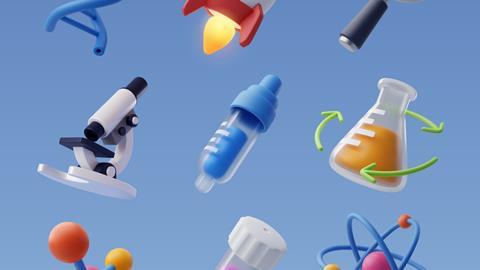A variety of molecular science project can take off thanks to an NWO Vidi grant. Ranging from CO2 fixation and supramolecular materials capable of learning to AI and sweet molecules.
This year’s round of NWO Vidi grants have just been announed. These grants, amounting to a maximum of €850,000, enable experienced researchers to set up their own research group and initiate an independent, innovative line of research. A total of 102 proposals have been granted, including 9 by members of KNCV, NBV and/or NVBMB.
We present them here in alphabetical order.
KNCV-member Marc Baggelaar, University of Utrecht
Greasy proteins in inflammation
Inflammation underlies difficult-to-treat conditions diseases like cancer, Alzheimer’s, and cardiovascular disorders. Numerous proteins crucial to the inflammatory response are modified with greasy molecules that change their function and localization. Little is known about those greasy modifications because they are difficult to dissolve in water for their analysis. The researches are going to develop new methods to study these greasy modifications in detail with the aim of identifying new strategies to treat inflammatory disorders.
NVBMB-member Christian Büll, Radboud University
How gut bacteria feast on sweet molecules
The human gut is populated by helpful bacteria that assist food digestion. To support these bacteria, the intestine produces a mucus slime layer consisting of proteins and sugar molecules. Gut bacteria break down mucus and they eat the freed proteins and sugars. Excessive mucus breakdown destroys the mucus layer leading to inflammation and Crohn’s disease. Many aspects of how bacteria degrade human mucus are unknown. Therefore, novel molecular probes and methods for measuring bacterial mucus breakdown will be developed. Moreover, molecules that stop excessive mucus degradation will be created to reduce inflammation in the gut.
NBV- and NVBMB-member Nico Claassens, Wageningen University & Research
Building more efficient routes for efficient CO2 fixation in bacteria
Many biological species, including all plants and also many bacteria can fix CO2. Almost all these species use the same metabolic route for this process: the Calvin cycle. Because this route wastes quite a lot of energy, alternative routes for CO2 fixation will be engineered and tested in a bacterium. After realizing these route it is expected that these bacteria can grow faster and make more products from CO2 and renewable hydrogen. These new CO2 fixation routes are a promising biological solution for more efficient biotechnological production and on the longer term potentially also more efficient agricultural crops.
NBV-member Ivana Drienovská, VU Amsterdam
Greening Our World: Unlocking Enzymatic Solutions for the Fluorination Reaction
Enzymes have massive potential for the sustainable production of chemicals. Unfortunately, the perfect enzyme for a specific task sometimes simply doesn’t exist in nature. Fluorination is one of the most desired chemical reactions, as more than 20% of all pharmaceuticals require it for their synthesis. In this proposal, researchers explore different artificial enzymes in order to find an efficient enzyme catalyst for this challenging reaction.
KNCV- and NVBMB-member Francesca Grisoni, Eindhoven University of Technology
Learning chemistry with artificial intelligence to accelerate drug discovery
Artificial intelligence (AI) has revolutionized numerous fields of science and technology. However, its full potential in discovering new pharmaceutical drugs remains untapped and is falling short of expectations. Stemming from this critical gap, ChemWISE will pioneer next-generation AI methods for drug discovery, with increased creativity and problem-solving capacities – to ultimately accelerate drug discovery.
NBV- and NVBMB-member Kristina Haslinger, University of Groningen
The biochemist’s alchemy - enzyme-powered innovation in pharmaceutical production
Many pharmaceutical drugs are based on chemicals found in nature. These chemicals are produced by plants, fungi, and bacteria with the help of specialized biocatalysts (enzymes). Biochemists can “borrow” these enzymes to build valuable chemicals on a large scale and in an environmentally friendly way. They can also produce new versions of such chemicals, with even more powerful pharmaceutical properties, by mixing and matching enzymes from different organisms in a combinatorial fashion. In this project, scientists will expand the catalogue of enzymes available for such a combinatorial approach and develop sustainable production routes for important pharmaceuticals.
KNCV Section CTC-member Tijs Karman, Radboud University
Quantum chemistry for quantum molecules
In addition to Bose-Einstein condensates of atoms, researchers have recently realized the first Bose-Einstein condensate of molecules; a quantum gas of molecules. Such quantum gases can be used to simulate electrons in materials, or for the development of upcoming quantum technologies. However, the properties of the molecular quantum gas are largely unexplored. The researcher will develop new and unconventional methods to describe molecular quantum gases based on methods from quantum chemistry, where these are applied to electrons instead of molecules.
NVBMB-member Francesca Mattiroli, Hubrecht Institute
How do cells copy the instructions on how to read their DNA?
Our DNA is packaged to instruct how, where and when its information is read. Every day our cells make a copy of their DNA and its packaging system before they divide. This ensures that their daughter cells accurately inherit the DNA information and its reading instructions. This is crucial to keep our tissues young and healthy. This research project will study how DNA and its packaging are duplicated, to identify new mechanisms to be targeted for fighting disease and aging.
KNCV-member Ghislaine Vantomme, Eindhoven University of Technology
Learning without neurons in supramolecular materials
In today’s era of big data, the need for new devices with higher performance and better energy efficiency is rapidly increasing. Inspired by the brain, functional materials able to compute themselves, with their active matter, are being explored as the next generation of computing hardware. A key facet of this challenge is to make materials that can be trained to store memory, learn, and make decisions. In this project, researchers will synthesize new molecules that can assemble into ordered nanostructures and be trained to recognize two-color images.













Nog geen opmerkingen